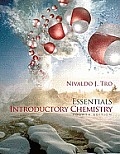Solutions Manual to accompany Introductory Chemistry Essentials 4th edition 9780321765802

Product details:
- ISBN-10 : 0321725999
- ISBN-13 : 978-0321725998
- Author: Nivaldo Tro
To succeed in introductory chemistry, you need to develop your problem-solving skills—but you’ll also need to understand why these skills are important. Introductory Chemistry Essentials, Fourth Edition extends chemistry from the laboratory to your world, helping you learn chemistry by demonstrating how it is manifested in your daily life. Throughout, the Fourth Edition presents a new student-friendly, step-by-step problem-solving approach that adds four steps to worked examples (Sort, Strategize, Solve, and Check).
Table contents:
Chapter 1 The Chemical World 1.1 Soda Pop Fizz 1.2 Chemicals Compose Ordinary Things 1.3 All Things Are Made of Atoms and Molecules 1.4 The Scientific Method: How Chemists Think EVERYDAY CHEMISTRY Combustion and the Scientific Method 1.5 A Beginning Chemist: How to Succeed Chapter 2 Measurement and Problem Solving 2.1 Measuring Global Temperatures 2.2 Scientific Notation: Writing Big and Small Numbers 2.3 Significant Figures: Writing Numbers to Reflect Precision Counting Significant Figures Exact Numbers CHEMISTRY IN THE MEDIA The COBE Satellite and Very Precise Measurements That Illuminate Our Cosmic Past 2.4 Significant Figures in Calculations Multiplication and Division Rounding Addition and Subtraction Calculations Involving Both Multiplication/Division and Addition/Subtraction 2.5 The Basic Units of Measurement The Standard units Prefix Multipliers Derived Units 2.6 Converting from One Unit to Another Problem-Solving Procedure Solving Unit Conversion Problems 2.7 Solving Multistep Conversion Problems CHEMISTRY AND HEALTH Drug Dosage 2.8 Units Raised to a Power 2.9 Density Calculating Density Density as a Conversion Factor CHEMISTRY AND HEALTH Density, Cholesterol, and Heart Disease 2.10 Numerical Problem-Solving Strategies and the Solution Map Problem-Solving Procedure Solving Numerical problems Chapter 3 Matter and Energy 3.1 In Your Room 3.2 What Is Matter? 3.3 Classifying Matter According to Its State: Solid, Liquid, and Gas 3.4 Classifying Matter According to Its Composition: Elements, Compounds, and Mixtures 3.5 How We Tell Different Kinds of Matter Apart: Physical and Chemical Properties 3.6 How Matter Changes: Physical and Chemical Changes 3.7 Conservation of Mass: There Is No New Matter 3.8 Energy Units of Energy CHEMISTRY IN THE MEDIA Perpetual Motion 3.9 Energy and Chemical and PhysIcal Change 3.10 Temperature: Random Molecular and Atomic Motion 3.11 Temperature Changes: Heat Capacity EVERYDAY CHEMISTRY Coolers, Camping, and the Heat Capacity of Water 3.12 Energy and Heat Capacity Calculations Chapter 4 Atoms and Elements 4.1 Experiencing Atoms at Tiburon 4.2 Indivisible: The Atomic Theory EVERYDAY CHEMISTRY Atoms and Humans 4.3 The Nuclear Atom 4.4 The Properties of Protons, Neutrons, and Electrons EVERYDAY CHEMISTRY Solid Matters? 4.5 Elements: Defined by Their Numbers of Protons 4.6 Looking for Patterns: The Periodic Law and the Periodic Table 4.7 Ions: Losing and Gaining Electrons Ions and the Periodic Table 4.8 Isotopes: When the Number of Neutrons Varies 4.9 Atomic Mass CHEMISTRY IN THE ENVIRONMENT Radioactive Isotopes at Hanford, Washington Chapter 5 Molecules and Compounds 5.1 Sugar and Salt 5.2 Compounds Display Constant Composition 5.3 Chemical Formulas: How to Represent Compounds 5.4 A Molecular View of Elements and Compounds Atomic Elements Molecular Elements Molecular Compounds Ionic Compounds 5.5 Writing Formulas for Ionic Compounds Problem-Solving Procedure Writing Formulas for Ionic Compounds 5.6 Nomenclature: Naming Compounds 5.7 Naming Ionic Compounds Naming Type I Binary Ionic Compounds Naming Type II Binary Ionic Compounds Naming Ionic Compounds Containing a Polyatomic Ion EVERYDAY CHEMISTRY Polyatomic Ions 5.8 Naming Molecular Compounds 5.9 Naming Acids Naming Binary Acids Naming Oxyacids 5.10 Nomenclature Summary Ionic Compounds Molecular Compounds Acids CHEMISTRY IN THE ENVIRONMENT Acid Rain 5.11 Formula Mass: The Mass of a Molecule or Formula Unit Chapter 6 Chemical Composition 6.1 How Much Sodium? 6.2 Counting Nails by the Pound 6.3 Counting Atoms by the Gram Converting between Moles and Number of Atoms Converting between Grams and Moles of an Element Converting Between Grams of an Element and Number of Atoms 6.4 Counting Molecules by the Gram Converting between Grams and Moles of a Compound Converting between Grams of a Compound and Number of Molecules 6.5 Chemical Formulas as Conversion Factors Converting between Moles of a compound and Moles of a Constituent Element Converting between Grams of a Compound and Grams of a Constituent Element 6.6 Mass Percent Composition of Compounds CHEMISTRY IN THE ENVIRONMENT Chlorine in Chlorofluorocarbons 6.7 Mass Percent Composition from a Chemical Formula CHEMISTRY AND HEALTH Fluoridation of Drinking Water 6.8 Calculating Empirical Formulas for Compounds Calculating an Empirical Formula from Experimental Data 6.9 Calculating Molecular Formulas for Compounds CHAPTER 7 Chemical Reactions 7.1 Kindergarten Volcanoes, Automobiles, and Laundry Detergents 7.2 Evidence of a Chemical Reaction 7.3 The Chemical Equation 7.4 How to Write Balanced Chemical Equations Problem-Solving Procedure Writing Balanced Chemical Equations 7.5 Aqueous Solutions and Solubility: Compounds Dissolved in Water Solubility 7.6 Precipitation Reactions: Reactions in Aqueous Solution That Form a Solid Predicting Precipitation Reactions Problem-Solving Procedure Writing Equations for Precipitation Reactions 7.7 Writing Chemical Equations for Reactions in Solution: Molecular, Complete Ionic, and Net Ionic Equations 7.8 Acid¿Base and Gas Evolution Reactions Acid-Base (Neutralization) Reactions Gas Evolution Reactions 7.9 Oxidation¿Reduction Reactions Combustion Reactions 7.10 Classifying Chemical Reactions Classifying Chemical Reactions by What Atoms Do Classification Flow Chart CHEMISTRY IN THE ENVIRONMENT The Reactions involved in Ozone Depletion Chapter 8 Quantities in Chemical Reactions 8.1 Global Warming: Too Much Carbon Dioxide 8.2 Making Pancakes: Relationships between Ingredients 8.3 Making Molecules: Mole-to-Mole Conversions CHEMISTRY IN THE MEDIA The Controversy over Oxygenated Fuels 8.4 Making Molecules: Mass-to-Mass Conversions 8.5 More Pancakes: Limiting Reactant, Theoretical Yield, and Percent Yield 8.6 Limiting Reactant, Theoretical Yield, and Percent Yield from Initial Masses of Reactants EVERYDAY CHEMISTRY Bunsen Burners 8.7 Enthalpy: A Measure of the Heat Evolved or Absorbed in a Reaction Chapter 9 Electrons in Atoms and the Periodic Table 9.1 Blimps, Balloons, and Models of the Atom 9.2 Light: Electromagnetic Radiation 9.3 The Electromagnetic Spectrum CHEMISTRY AND HEALTH Radiation Treatment for Cancer 9.4 The Bohr Model: Atoms with Orbits 9.5 The Quantum-Mechanical Model: Atoms with Orbitals Baseball Paths and Electron Probability Maps From Orbits to Orbitals 9.6 Quantum-Mechanical Orbitals CHEMISTRY AND HEALTH Magnetic Resonance Imaging Electron Configurations: how Electrons Occupy Orbitals 9.7 Electron Configurations and the Periodic Table Valence Electrons 9.8 The Explanatory Power of the Quantum-Mechanical Model 9.9 Periodic Trends: Atomic Size, Ionization Energy, and Metallic Character Atomic Size CHEMISTRY AND HEALTH Pumping Ions: Atomic Size and Nerve Impulses Ionization Energy Metallic Character Chapter 10 Chemical Bonding 10.1 Bonding Models and AIDS Drugs 10.2 Representing Valence Electrons with Dots 10.3 Lewis Structures for Ionic Compounds: Electrons Transferred 10.4 Covalent Lewis Structures: Electrons Shared Double and Triple Bonds 10.5 Writing Lewis Structures for Covalent Compounds Problem-Solving Procedure Writing Lewis Structures for Covalent Compounds Writing Lewis Structures for Polyatomic Ions Exceptions to the Octet Rule 10.6 Resonance: Equivalent Lewis Structures for the Same Molecule CHEMISTRY IN THE ENVIRONMENT The Lewis Structure of Ozone 10.7 Predicting the Shapes of Molecules Problem-Solving Procedure Predicting Geometry using VSEPR 10.8 Electronegativity and Polarity: Why Oil and Water Don¿t Mix Electronnegativity Polar Bonds and Polar Molecules EVERYDAY CHEMISTRY How Soap Works Chapter 11 Gases 11.1 Extra-long Straws 11.2 Kinetic Molecular Theory: A Model for Gases 11.3 Pressure: The Result of Constant Molecular Collisions Pressure Units Pressure Unit Conversion EVERYDAY CHEMISTRY Airplane Cabin Pressurization 11.4 Boyle¿s Law: Pressure and Volume EVERYDAY CHEMISTRY Extralong Snorkels 11.5 Charles¿s Law: Volume and Temperature 11.6 The Combined Gas Law: Pressure, Volume, and Temperature 11.7 Avogadro¿s Law: Volume and Moles 11.8 The Ideal Gas Law: Pressure, Volume, Temperature, and Moles Molar Mass of a Gas from the Ideal Gas Law 11.9 Mixtures of Gases: Why Deep-Sea Divers Breathe a Mixture of Helium and Oxygen Deep-Sea Diving and Partial Pressure Collecting Gases over Water 11.10 Gases in Chemical Reactions Molar Volume at Standard Temperature and Pressure CHEMISTRY IN THE ENVIRONMENT Air Pollution Chapter 12 Liquids, Solids, and Intermolecular Forces 12.1 Interactions between Molecules 12.2 Properties of Liquids and Solids Properties of Liquids Properties of Solids 12.3 Intermolecular Forces in Action: Surface Tension and Viscosity Surface Tension Viscosity EVERYDAY CHEMISTRY Why Are Water Drops Spherical? 12.4 Evaporation and Condensation Boiling Energetics of Evaporation and Condensation Heat of Vaporization 12.5 Melting, Freezing, and Sublimation Energetics of Melting and Freezing Heat of Fusion Sublimation 12.6 Types of Intermolecular Forces: Dispersion, Dipole¿Dipole, and Hydrogen Bonding Dispersion Force Dipole-Dipole Force Hydrogen Bonding 12.7 Types of Crystalline Solids: Molecular, Ionic, and Atomic CHEMISTRY AND HEALTH Hydrogen Bonding in DNA Molecular Solids Ionic Solids Atomic Solids 12.8 Water: A Remarkable Molecule CHEMISTRY IN THE ENVIRONMENT Water Pollution `Chapter 13 Solutions 13.1 Tragedy in Cameroon 13.2 Solutions: Homogenous Mixtures 13.3 Solutions of Solids Dissolved in Water: How to Make Rock Candy Solubility and Saturation Electrolyte Solutions: Dissolved Ionic Solids How Solubility Varies with Temperature Rock Candy 13.4 Solutions of Gases in Water: How Soda Pop Gets Its Fizz 13.5 Specifying Solution Concentration: Mass Percent Mass percent Using Mass Percent in Calculations CHEMISTRY IN THE ENVIRONMENT The Dirty Dozen 13.6 Specifying Solution Concentration: Molarity Using Molarity in Calculations Ion Concentrations 13.7 Solution Dilution 13.8 Solution Stoichiometry 13.9 Freezing Point Depression and Boiling Point Elevation: Making Water Freeze Colder and Boil Hotter Freezing Point Depression Boiling Point Elevation EVERYDAY CHEMISTRY Antifreeze in Frogs 13.10 Osmosis: Why Drinking Salt Water Causes Dehydration CHEMISTRY AND HEALTH Solutions in Medicine CHAPTER 14 Acids and Bases 14.1 Sour Patch Kids and International Spy Movies 14.2 Acids: Properties and Examples 14.3 Bases: Properties and Examples 14.4 Molecular Definitions of Acids and Bases The Arrhenius Definition The Bronsted-Lowry Definition 14.5 Reactions of Acids and Bases Neutralization Reactions Acid Reactions Base Reactions EVERYDAY CHEMISTRY What is in My Antacid? 14.6 Acid¿Base Titrations: A Way to Quantify the Amount of Acid or Base in a Solution 14.7 Strong and Weak Acids and Bases Strong Acids Weak Acids Strong Bases Weak Bases 14.8 Water: Acid and Base in One 14.9 The pH and pOH Scale: Ways to Express Acidity and Basicity Calculating pH from [H3O+] Calculating [H3O+] from pH CHEMISTRY AND HEALTH Ulcers 14.10 Buffers: Solutions That Resist pH Change CHEMISTRY AND HEALTH The Danger of Antifreeze 14.11 Acid Rain: An Environmental Problem Related to Fossil Fuel Acid Rain Damage Acid Rain Legislation Chapter 15 Chemical Equilibrium 15.1 Life: Controlled Disequilibrium 15.2 The Rate of a Chemical Reaction Collision Theory How Concentration Affects the Rate of a Reaction How Temperature Affects the Rate of a Reaction 15.3 The Idea of Dynamic Chemical Equilibrium 15.4 The Equilibrium Constant: A Measure of How Far a Reaction Goes Writing Equilibrium Expressions for Chemical Reactions The Significance of the Equilibrium Constant 15.5 Heterogeneous Equilibria: The Equilibrium Expression for Reactions Involving a Solid or a Liquid 15.6 Calculating and Using Equilibrium Constants Calculating Equilibrium Constants Using Equilibrium Constants in Calculations 15.7 Disturbing a Reaction at Equilibrium: Le Châtelier¿s Principle 15.8 The Effect of a Concentration Change on Equilibrium CHEMISTRY AND HEALTH How a Developing Fetus Gets Oxygen from Its Mother 15.9 The Effect of a Volume Change on Equilibrium 15.10 The Effect of a Temperature Change on Equilibrium 15.11 The Solubility-Product Constant Using Ksp to Determine Molar Solubility EVERYDAY CHEMISTRY Hard Water 15.12 The Path of a Reaction and the Effect of a Catalyst Combustion How Activation Energies Affect Reaction Rates Catalysts Lower the Activation Energy Enzymes: Biological Catalysts Chapter 16 Oxidation and Reduction 16.1 The End of the Internal Combustion Engine? 16.2 Oxidation and Reduction: Some Definitions 16.3 Oxidation States: Electron Bookkeeping EVERYDAY CHEMISTRY The Bleaching of Hair 16.4 Balancing Redox Equations Problem-Solving Procedure Balancing Redox Equations Using the Half-Reaction Method CHEMISTRY IN THE ENVIRONMENT Photosynthesis and Respiration: Energy for Life 16.5 The Activity Series: Predicting Spontaneous Redox Reactions Predicting Whether a Metal Will Dissolve in Acid 16.6 Batteries: Using Chemistry to Generate Electricity Dry-Cell Batteries Lead-Acid Storage Batteries Fuel Cells 16.7 Electrolysis: Using Electricity to Do Chemistry 16.8 Corrosion: Undesirable Redox Reactions EVERYDAY CHEMISTRY The Fuel-Cell Breathalyzer Chapter 17 Radioactivity and Nuclear Chemistry 17.1 Diagnosing Appendicitis 17.2 The Discovery of Radioactivity 17.3 Types of Radioactivity: Alpha, Beta, and Gamma Decay Alpha (a) Radiation Beta (B) Radiation Gamma (y) Radiation Positron Emission 17.4 Detecting Radioactivity 17.5 Natural Radioactivity and Half-Life A Natural Radioactive Decay Series CHEMISTRY AND HEALTH Environmental Radon 17.6 Radiocarbon Dating: Using Radioactivity to Measure the Age of Fossils and Other Artifacts CHEMISTRY IN THE MEDIA The Shroud of Turin 17.7 The Discovery of Fission and the Atomic Bomb 17.8 Nuclear Power: Using Fission to Generate Electricity 17.9 Nuclear Fusion: The Power of the Sun 17.10 The Effects of Radiation on Life Acute Radiation Damage Increased Cancer Risk Genetic Defects Measuring Radiation Exposure 17.11 Radioactivity in Medicine Isotope Scanning Radiotherapy Problem-Solving Procedures Solving Unit Conversion Problems Solving Numerical Problems Writing Formulas for Ionic Compounds Obtaining an Empirical Formula from Experimental Data Writing Balanced Chemical Equations Writing Equations for Precipitation Reactions Writing Lewis Structures for Covalent Compounds Predicting Geometry Using VSEPR Balancing Redox Equations Using the Half-Reaction Method Naming Alkanes PHOTO CREDITS PC-1 Index I-1
People also search:
introductory chemistry essentials
introductory chemistry fifth edition answers
general chemistry 4th edition answers
introductory chemistry lab manual answers





